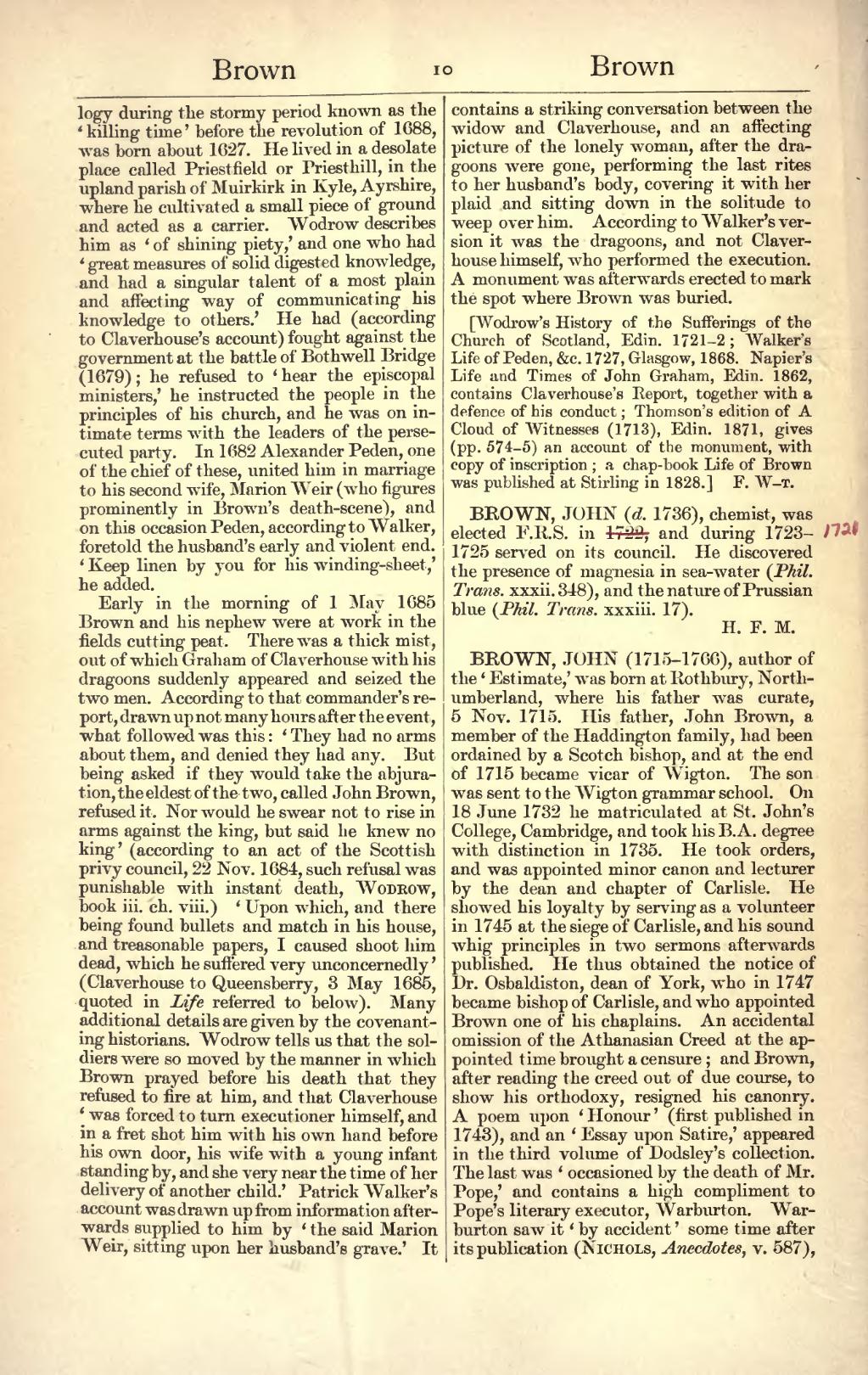logy during the stormy period known as the 'killing time' before the revolution of 1688, was born about 1627. He lived in a desolate place called Priestfield or Priesthill, in the upland parish of Muirkirk in Kyle, Ayrshire, where he cultivated a small piece of ground and acted as a carrier. Wodrow describes him as 'of shining piety,' and one who had 'great measures of solid digested knowledge, and had a singular talent of a most plain and affecting way of communicating his knowledge to others.' He had (according to Claverhouse's account) fought against the government at the battle of Bothwell Bridge (1679); he refused to 'hear the episcopal ministers,' he instructed the people in the principles of his church, and he was on intimate terms with the leaders of the persecuted party. In 1682 Alexander Peden, one of the chief of these, united him in marriage to his second wife, Marion Weir (who figures prominently in Brown's death-scene), and on this occasion Peden, according to Walker, foretold the husband's early and violent end. 'Keep linen by you for his winding-sheet,' he added.
Early in the morning of 1 May 1685 Brown and his nephew were at work in the fields cutting peat. There was a thick mist, out of which Graham of Claverhouse with his dragoons suddenly appeared and seized the two men. According to that commander's report, drawn up not many hours after the event, what followed was this: 'They had no arms about them, and denied they had any. But being asked if they would take the abjuraration, the eldest of the two, called John Brown, refused it. Nor would he swear not to rise in arms against the king, but said he knew no king' (according to an act of the Scottish privy council, 22 Nov. 1684, such refusal was punishable with instant death, Wodrow, book iii. ch. viii.) 'Upon which, and there being found bullets and match in his house, and treasonable papers, I caused shoot him dead, which he suffered very unconcernedly' (Claverhouse to Queensberry, 3 May 1685, quoted in Life referred to below). Many additional details are given by the covenanting historians. Wodrow tells us that the soldiers were so moved by the manner in which Brown prayed before his death that they refused to fire at him, and that Claverhouse 'was forced to turn executioner himself, and in a fret shot him with his own hand before his own door, his wife with a young infant standing by, and she very near the time of her delivery of another child.' Patrick Walker's account was drawn up from information afterwards supplied to him by 'the said Marion Weir, sitting upon her husband's grave.' It contains a striking conversation between the widow and Claverhouse, and an affecting picture of the lonely woman, after the dragoons were gone, performing the last rites to her husband's body, covering it with her plaid and sitting down in the solitude to weep over him. According to Walker's version it was the dragoons, and not Claverhouse himself, who performed the execution. A monument was afterwards erected to mark the spot where Brown was buried.
[Wodrow's History of the Sufferings of the Church of Scotland. Edin. 1721-2; Walker's Life of Peden, &c. 1727, Glasgow, 1868. Napier's Life and Times of John Graham, Edin. 1862, contains Claverhouse's Report, together with a defence of his conduct; Thomson's edition of A Cloud of Witnesses (1713), Edin. 1871, gives (pp. 574-5) an account of the monument, with copy of inscription; a chap-book Life of Brown was published at Stirling in 1828.]
BROWN, JOHN (d. 1736), chemist, was elected F.R.S. in 1722, and during 1723-1725 served on its council. He discovered the presence of magnesia in sea-water (Phil. Trans. xxxii. 348), and the nature of Prussian blue (Phil. Trans. xxxiii. 17).
BROWN, JOHN (1715–1766), author of the 'Estimate,' was born at Rothbury, Northumberland, where his father was curate, 5 Nov. 1715. His father, John Brown, a member of the Haddington family, had been ordained by a Scotch bishop, and at the end of 1715 became vicar of Wigton. The son was sent to the Wigton grammar school. On 18 June 1732 he matriculated at St. John's College, Cambridge, and took his B. A. degree with distinction in 1735. He took orders, and was appointed minor canon and lecturer by the dean and chapter of Carlisle. He showed his loyalty by serving as a volunteer in 1745 at the siege of Carlisle, and his sound whig principles in two sermons afterwards published. He thus obtained the notice of Dr. Osbaldiston, dean of York, who in 1747 became bishop of Carlisle, and who appointed Brown one of his chaplains. An accidental omission of the Athanasian Creed at the appointed time brought a censure; and Brown, after reading the creed out of due course, to show his orthodoxy, resigned his canonry. A poem upon 'Honour' (first published in 1743), and an 'Essay upon Satire,' appeared in the third volume of Dodsley's collection. The last was 'occasioned by the death of Mr. Pope,' and contains a high compliment to Pope's literary executor, Warburton. Warburton saw it 'by accident' some time after its publication (Nichols, Anecdotes, v. 587),
